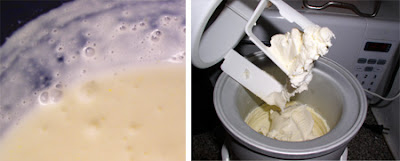
So the big week is finally here: I’ve decided to spend the next five days immersing myself in the diet of the Battle Creek Sanitarium and John Harvey Kellogg. I’m not sure what to tell you to expect–either the delightful world of vegetarian cuisine, or another week of torture comparable to the Tenement Diet.
Protose is one of J. H. Kellog’s invented meat substitutes. I currently have it on my menu for the Dinner on the Road to Wellville party in March. I’m skeptical that it’s not horrible, so I want to give it a try in advance, so that i have time to come up with a suitable replacement, if necessary.
Protose was manufactured by the Kellogg/Worthington company until about 2000; since it was discontinued, there seems to be an online group of hard-core vegans trying to recreated it’s special taste and texture. While searching for a suitable recipe, I came across this fascinating recollection of one man’s experience with the cuisine of J.H, Kellogg:
“Protose. What does that conjure up for me?
You’d never guess.
The three most trusted people that Dr. J.H. Kellogg had working for him were three unmarried sisters: Gertrude, his chief administrator and executor of his will; Angie his chief dietitians; and Mable his chief nurse and the one person who accompanied Kellogg to Ontario to attend the Dion quintuplets.
By the mid-1950’s, the doctor long dead, the three unmarried sisters now running the Sanitarium in Miami Springs would spend the summers back up in Battle Creek at their farm in the country.
My grandfather was the brother to these three sisters and, dying young, my own father was raised by the sisters and Dr. Kellogg.
During the summers we would visit them three or four times for a weekend and invariably one of the meals was the most delicious “roast” made out of Protose. Once you’ve had it, especially the way they prepared it, you were hooked.”
I can’t confirm whether the story is true, but fascinating none the less.
After further research, I came up with this recipe:
***
1/2 cup creamy, natural peanut butter
1 cup wheat gluten (seitan)
1 c vegetable stock
2 T cornstarch
1/2 a medium onion, chopped
1 tsp Italian herb blend
Pinch of salt
Steam in top of a double boiler for three hours, stirring occasionally. Let cool in the pan, turn out on platter and slice.
***
Seitan, if you were wondering, is a vegan food product invented by Buddhist monks in China. You take wheat dough and wash it under water until nothing remains but the gluten. It’s very high in protein, but it also looks like this:

I tasted a tiny bit of it out of the bag. It had a bizarre taste I wasn’t expecting: like burnt maple syrup. Very unappealing.
I buzzed the seitan in a food processor and mixed it up with all the other ingredients. I found out I didn’t have corn starch, so I ended using flour instead. I used McCormick’s Italian Herb Grinder for the seasoning. I took a tiny taste of the mixed ingredients and it tasted like…peanut butter with Italian seasoning.
I set it on a double boiler, and it looked done after about two hours. I flipped it out of the mold and it looked pretty unappealing. I’m preparing it in a dish for dinner today, so we’ll see how that goes. But I have a feeling I’m going to end up taking this one off the menu.
 I’m planning an Ice Cream Social for the late spring, possibly to coincide with the Kentucky Derby. So I wanted to begin testing out a few ice cream recipes, and I decided to use the menu for Lincoln’s second inaugural banquet as a reference. Because if it was good enough for Lincoln, it’s good enough for me!
I’m planning an Ice Cream Social for the late spring, possibly to coincide with the Kentucky Derby. So I wanted to begin testing out a few ice cream recipes, and I decided to use the menu for Lincoln’s second inaugural banquet as a reference. Because if it was good enough for Lincoln, it’s good enough for me! 
 Left: The mixture of cream, sugar and lemon steeps. Right: Coming out of the ice cream maker. I left it in a little too long and it got a little buttery, but it was still good.
Left: The mixture of cream, sugar and lemon steeps. Right: Coming out of the ice cream maker. I left it in a little too long and it got a little buttery, but it was still good.










